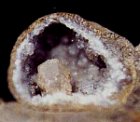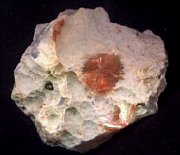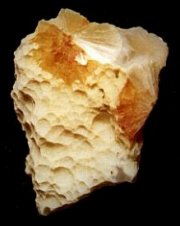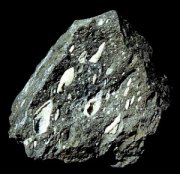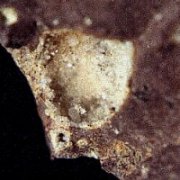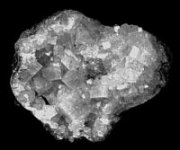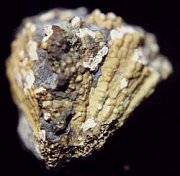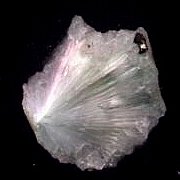 |
|||
|
|||
|
Copyright
Zeolites from the Kamloops Region
IntroductionZeolites are a group of related hydrous tectosilicate minerals, very popular among collectors, that occur in cavities of basic igneous rocks, especially vesicular basalt. They contain water in microscopic channels within a framework; the water can be driven off (by heat) or replaced without altering the structure of the zeolite minerals.
Listed below are some localities in the Kamloops region. I have named several of the different varieties of zeolites. When collecting these minerals, be patient. But do not be afraid to break some rocks, as these zeolites will not disappear on you. There are plenty to be found at these localities. Town of Cache CreekNatrolite, AnalcimeCoarse natrolite needles, up to 9 mm long, with pyramidal terminations are found on colourless trapezohedra of analcime on the north side of the road following the (Cache) Creek, approximately 5 miles northeast of the town of Cache Creek. Further, up this road leads to the erionite locality in Pass Valley. Gold Pan Camp, Spences Bridge, Fraser River Canyon, Cache Creek Regions:Heulandite (pink), Laumontite, Chabazite, Epistilbite, Stilbite, ColmaniteWhite prisms of laumontite are found on quartz and pumpellyite at Spences Bridge, in the Fraser River Canyon. Colourless, transparent epistilbite crystals, up to 2 mm long, are rarely found at Gold Pan Camp, near Spences Bridge, but abundant pink heulandite crystals can be found directly across from the entrance to the park in the road cut.
Kamloops Lake Region:Ferrierite, Chalcedony, Goethite, Calcite, ClinoptiloliteThe railway cut on the north shore of Kamloops Lake, west of the city of Kamloops is still the best and most abundant locality in the world for Ferrierite. Ferrierite is abundant in weathered olivine basalt pillows and flow-breccia that extend for 1 km along the railway, on the hill above the railway cut, and along the shore of Kamloops Lake. Calcite-chalcedony-filled nodules are lined with small, red, radiating groups of ferrierite that may reach 8 cm to 25cm in diameter. Ferrierite commonly lines the walls of veins, up to 10 cm thick and 4 meters long, that are filled with an intergrowth of calcite and chalcedony. Rarely, geodes, up to 13 cm by 30 cm in diameter, are lined with ferrierite, covered by amethyst or clear quartz crystals, calcite crystals, and small, brown needles of Goethite. The largest crystals can reach 3 mm wide, 1 mm thick, and up to 15 mm long, forming large, colourless to cream-coloured aggregates, from 2 mm to over 3 cm in diameter. The cavities are coated by a light green clay, which is covered by an egg-shell-thin chalcedony layer that preceded radial groups and linings of bladed Ferrierite. Collecting is excellent and allowed – with the permission of Mr. Bob Campbell in Kamloops.
Twig Creek, Monte Hills,
Heulandite, Analcime, Levyne, Stilbite, Thomsonite, Paulingite with Erionite and Offretite |
||||||||||
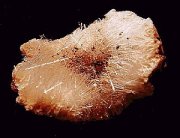 Natrolite.
|
Monte Lake, Kamloops Region:
Ferrierite, Calcite, GoethiteColourless, salmon-orange, and red, Mg-rich ferrierite is found in calcite filled vesicles and veins along the east side of Monte Lake in altered Middle Tertiary basalts and in railway cuts southeast of the lake. Calcite-filled ferrierite-lined nodules and veins, up to 8 inches across, are found in highly weathered basalt in a road cut along Highway 97 between Blue Fountain Campsite and the government campsite along Monte Lake. Additional calcite-filled nodules lined with beige coloured ferrierite are found in railway cuts south of Monte Lake just south of where the railway crosses Highway 97. Calcite co-crystallised with much of the ferrierite and interfered with its growth producing poorly formed crystals. Excellent free growing ferrierite blades, up to 8 mm long, associated with calcite crystals are found in cavities, up to 3 inches across, near the 3rd telephone pole south of a side road along the lake between the government camp and the railroad crossing. The best rock has fallen from 15 to 20 feet from a vesicular portion of a flow in the cliff. Much of the ferrierite is coloured very attractive shades of orange and red from iron oxides and make excellent specimens. Large chalcedony nodules and quartz geodes are present. A few pockets, up to 6 inches, are found in the cliffs along the railway southeast of the lake that contain exceptionally long, thin, free-growing ferrierite crystals, up to 3 inches long and only 1 mm wide.
Douglas Lake Road, Westwold,
Kamloops Region:
Chabazite, Thomsonite, Stilbite, Heulandite, Levyne, Offretite, Calcite, Mesolite, Cowlesite, Phillipsite, Goethite
Basalt talus slopes and cliffs along the Douglas Lake Road, 9 to 10 miles west of Westwold, contain levyne plates overgrown with, white, yellow, or orange, silky offretite needles, 2 to 3 mm long. The offretite covers the edges of the levyne to form simple appearing short, hexagonal prisms terminated by a broad, rough, basal pinacoid that is composed of thousands of offretite needles, all parallel to each other and to the c-axis of the tiny thin levyne plate buried inside. Found in nearby cavities are light-grey cowlesite blades (lining vesicles up to 10 cm in diameter), bladed thomsonite, rhombohedra of chabazite (small and colourless), radial aggregates of phillipsite crystals (brownish-tan to colourless), stilbite (up to 10 mm in diameter), heulandite, mesolite (thin, hairlike needles) and calcite.
It is hoped that this article has given you a better understanding of the small world of zeolites. There are many more zeolite locations in the Kamloops region of British Columbia. However, they are too numerous to mention here. If you want to know more about the localities mentioned, or others not mentioned, feel free to contact me anytime.
Copyright ©1999 John Ratcliffe
E-mail: ratcliffe@mail.ocis.net
Website: www.ocis.net/~ratcliff/index.html
This article may not be copied, distributed or reprinted in any form without the author's permission. To contact the author, please use the e-mail address provided. If you are unable to contact the author, please contact the Canadian Rockhound. Authorized reprints must acknowledge the author and the Canadian Rockhound, and include the website URL address of the Canadian Rockhound.
Document Number: CR993203

Copyright © 1999 Canadian Rockhound
Webpage design by H. J. Schmid & Associates, Inc.
Winnipeg, Manitoba, Canada
Magazine Issues |
News & Events |
Junior Rockhound |
Resources
Clubs |
Dealers |
Classifieds |
Web Links |
Home
